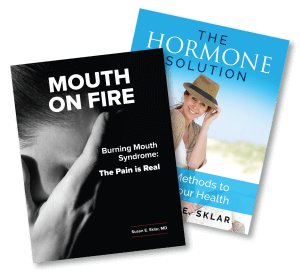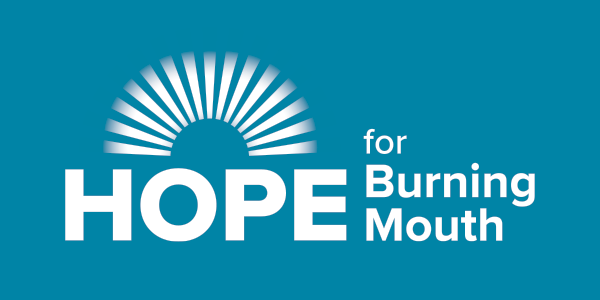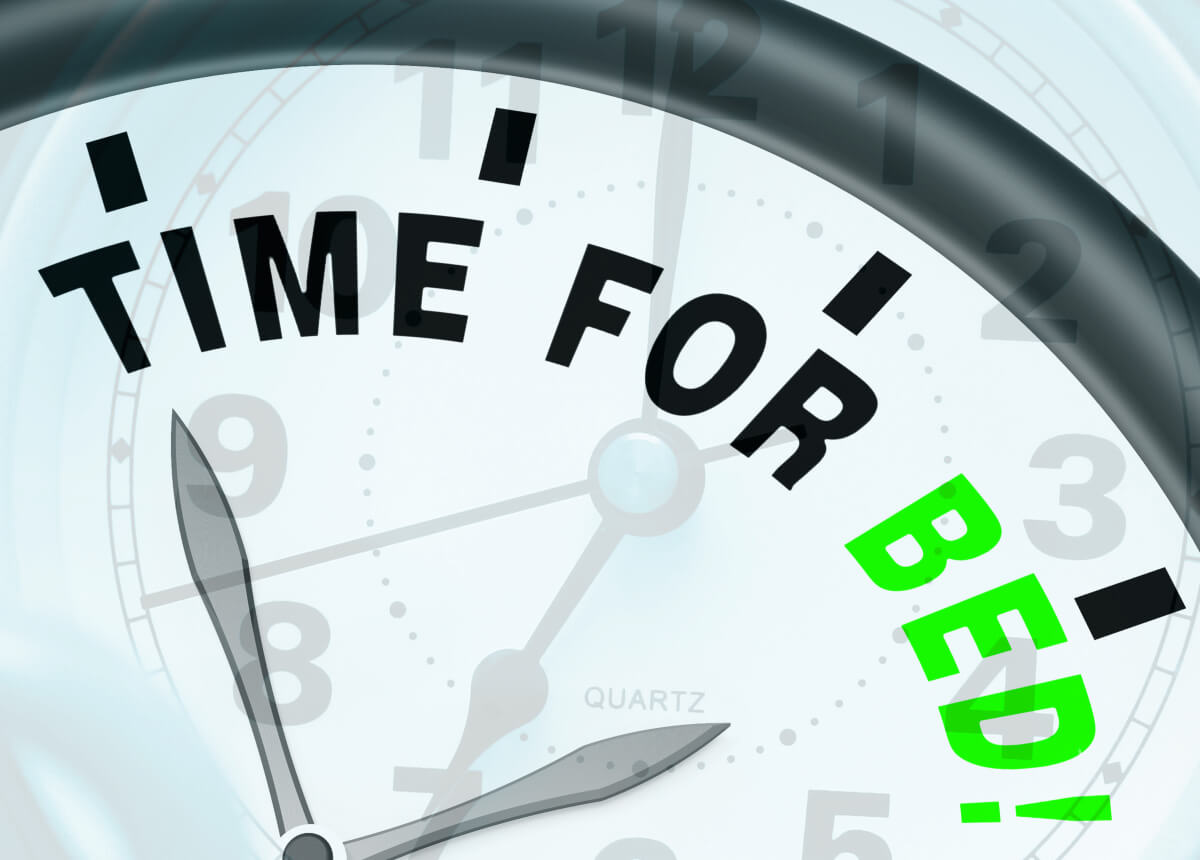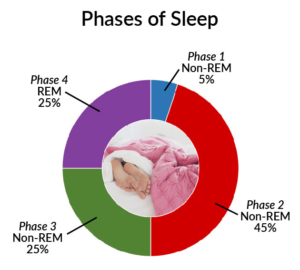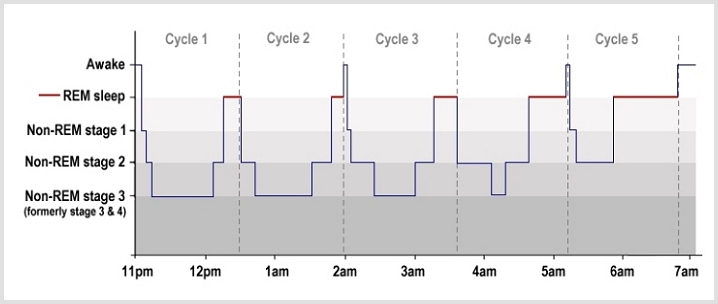Improving Sleep: Part 2
Improving our sleep may be the most important change in lifestyle a person can make to ensure physical and mental health. As a functional medicine doctor, Dr. Sklar understands the foundational importance of sleep to energy as well as overall health. One of the biggest causes of fatigue is sleep problems. Today’s modern society is fast paced, complicated, and anxiety producing. Sleep is sacrificed on the altar of modernity, productivity, and technology. Restoring and improving sleep will increase energy, prevent disease, calm the mind, and ensure overall well-being.
What are the Phases of Sleep?
In order to improve your sleep, it’s important to understand what the different parts of sleep do for you, and to know the importance of getting a full night’s sleep. Although this is conventional medical knowledge, Dr. Sklar has an alternative medicine approach to helping sleep disorders. Pharmaceutical drugs for sleep have long term harmful and possibly addictive actions. Dr. Sklar’s knowledge as an alternative medicine doctor provides you with safe, natural, herbal alternatives to help your sleep.
It is also important to know why shorting yourself on sleep by getting up extra early is harmful. You may thing you are gaining by waking up at 5:00 instead of 6:30 to get a whole bunch of important things done but in the long run, you are actually decreasing your health and productivity.
Sleep has two phases; non-REM and REM sleep. REM stands for rapid eye movement. REM sleep is the phase of sleep when you’re paralyzed, except for below the neck. Scary to think about. So, your eyes move, but nothing else in your body can move. In Non-REM sleep, your eyes don’t move, and your body is able to move.
This chart shows you the sleep phases. REM sleep is in red. It is not the deepest level of sleep. Non-REM sleep is in blue. It has some of the deepest levels of sleep. Your body starts going down, down, down to the deepest stage of sleep. It’s hard to arouse people when they’re in the deepest stage of sleep.
What is Non-REM Sleep?
At the beginning of the night, you spend most of your time in non-REM sleep. As it starts getting to three, four, or five AM, the REM sleep increases. And by six to seven in the morning, more than half your sleep is REM sleep.
Non-REM sleep ends up being about 75 or 80% of the total amount of your sleep. And what happens during this phase is the brain files the new memories away. It’s like having a messy stack of papers representing everything that happened the day before and filing it into a system of file folders and drawers. And that happens during stage two non-REM sleep.
The other thing that happens during non-REM sleep is tissue growth and repair. The way this works is the pituitary gland releases human growth hormone. This hormone helps repair all the damaged tissue that’s happened during the day.
What is REM Sleep?
During REM sleep is your eyes move, but your body doesn’t. And this is the phase of sleep where you’re dreaming. If your body kept moving while you were dreaming, you would be up and running around. And there are people who have something called REM behavioral disorder where their bodies do not get paralyzed during REM sleep and they are up doing things, sometimes bad things like attacking their partner, because they don’t know it’s a dream. So, it’s a serious sleep disorder.
REM sleep activates certain parts of your brain. Your brain is very divided into areas that have different responsibilities. Consequently, REM sleep cases activation of your vision center which is in the back of your brain and the motor cortex, which makes your arms and legs move.
The other thing that gets activated is the hippocampus. That’s where you lay down new memories. And the amygdala, which is our emotional fear center of the brain. As a result, REM sleep activates all these parts of the brain. Our eyes move. But when we dream our muscles do not move, they are paralyzed.
What are the Benefits of REM Sleep?
REM sleep is your creative time of night and is important to improving sleep. This is when the brain blends memories in with everything about who you are and what you know. And if you short yourself here and wake up at five in the morning instead of seven, you are going to lose the opportunity for your creativity and the blending of everything that happened the day before into what you already know. Frequently, when people say, “I’ll sleep on it”, they’re really sleeping on it and working out the problems.
Moreover, there are examples from history of the Russian scientist who developed the atomic chart, which is a layout of all the different elements in a pattern. He could never figure the pattern out. He walked around with decks of cards that had all the elements on them, and he’d lay them out and try to figure out what the patterns were.
After several nights staying awake all night, he crashed and went to sleep. And when he woke up, he saw the whole atomic chart.[1]
REM sleep can be a highly creative time, and it’s vital to new learning. This is the time of sleep when we not only have filed away our memories, but our memories become part of who we are. As a result, this whole creativity ability of our brain to emotionally connect to other people happens in REM sleep and is what makes us human and different from the rest of the animal kingdom.[2]
Sleep Problems: Sleep Deprivation and Insomnia.
Sleep deprivation is when we can sleep, but we don’t allow ourselves enough time to sleep. That’s something that’s very much under your control. You need to allow more time to sleep. In today’s world many people are either forced or driven by a need for professional advancement or the demands of their small businesses.
The most common examples are medical residents and lawyers. Medical residents may routinely work 24-hour shifts. Young lawyers of large firms who want to become partners may work 18 to 20 hours and sleep on a bed in their office provided by the company. The modern Silicon Valley workplace supplies all day and night meal service and sleeping rooms.
The breakdown of traditional 9 to 5 work routines has led to an epidemic of sleep deprivation. Changing jobs, controlling schedules making time for sleep if possible, solves the problem of sleep deprivation.
The Insomnia Epidemic
Insomnia is a sleep problem that includes difficulty falling and/or staying asleep. It is a situation where you don’t have the ability to sleep even if you give yourself plenty of time. If you can understand what is happening, you can improve your sleep.
What are the criteria for insomnia? One is, are you dissatisfied with the quantity or the quality of your sleep? Do you have distress or daytime impairment because of sleep problems? Do you have problems sleeping at least three times a week and has it gone on more than three months? And this needs to be in the absence of mental disorders or medical conditions that also could cause insomnia: anxiety, depression. Certainly, medications can keep people from sleeping.
The official definition of insomnia is:
(1) difficulty falling asleep, staying asleep or non-restorative sleep
(2) this difficulty is present despite adequate opportunity and circumstance to sleep
(3) this impairment in sleep is associated with daytime impairment or distress
(4) this sleep difficulty occurs at least 3 times per week and has been a problem for at least 1 month.[3]
The insomnia epidemic is in some circles thought to be the number one health related problem in America. Even though one in nine people only have the official definition of insomnia, experts estimate that one out of three Americans will have trouble sleeping every single night–more women than men.
Two thirds of women said they have problems sleeping at least a few nights each week. Half of respondents to a survey said that daytime sleepiness interferes with their normal daytime activities. That’s huge. We think it affects 40 million people, more in African Americans and Hispanics than in Caucasians.
Why Do People Have Insomnia?
There certainly is a genetic component. I have heard things like, “Yeah, my father didn’t sleep, and my mother didn’t sleep. So that’s why I don’t sleep.” It seems like it could be a learned behavior rather than genetic, but in fact, there is a genetic part. Genes account for anywhere between 28 and 45% of difficulty sleeping. [4]
Loss of Hormones Causes Sleep Problems
Loss of hormones, especially progesterone, occurs during the perimenopause and menopause transition. Progesterone is a very brain calming, sleep enhancing hormone. In addition to loss of progesterone, there is loss of estrogen. This causes hot flashes and night sweats, which wake women up, sometimes multiple times a night. Restoring and balancing these hormones with bio-identical hormones are a simple and effective fix for this problem.
Some Diseases Cause Sleep Problems
Some diseases like Parkinson’s have insomnia as part of their pattern of symptoms. Certainly, we see in Alzheimer’s a lot of disordered sleep of one kind or another. The very areas that begin the decline in cognition of Alzheimer’s disease are the exact areas that are responsible for generation of sleep. So, sleep is intimately connected to Alzheimer’s disease.
Medication Plays a Role in Sleep Quality
Certain medications will interfere with sleep. If you use an asthma inhaler to dilate the bronchioles and the passages in your lungs, you may experience sleep problems. The medicine is an epinephrine, “fight or flight” type of chemical. This medicine puts your body on high alert. Therefore, using it can keep you feeling hyper and awake.
There are also medications like steroids that for some people have tremendous sleep disrupting properties.
Improving Sleep by Correcting Breathing Problems
Sleep apnea or what we call sleep disordered breathing can be a major cause of disrupted sleep and with that, an increased risk of diabetes, heart disease and Alzheimer’s. Aside from frequent awakening, symptoms include still feeling tired on awakening and frequent urination at night.
Bladder problems are disruptive to sleep as people age, but there are some people who wake up five to six times a night to use the bathroom. This can be a sign that you have low oxygen during sleep. I recommend getting a sleep study done to see if in fact you are having low oxygen at night.
Then, there is something that affects women more than men called “sleep disordered breathing.” That’s a much more subtle sleep problem than sleep apnea and it’s a condition that affects a lot people who thin faces and long thin necks. It has to do with the development of the jaw and the facial bones during infancy and childhood.
When women with this problem lie down, their tracheas narrow down to an extremely small diameter. Therefore, they periodically through the night do not get adequate air through their windpipes. And so, they have multiple drops in oxygenation.
It takes a special evaluation with a high-resolution pulse oximeter home sleep test to diagnose this problem. And, because of the connection between sleep and cognition, we recommend some sort of sleep evaluation in anyone with a significant cognition problem.
Bright Lights and Warm Temperatures Disrupt Sleep
Bright light will keep you awake. Light and dark cycles of the sun and the moon trigger sleep. If your room is too bright, you will not sleep as deeply. It will inhibit the release of melatonin, which is an important sleep hormone.
The wrong room temperature is also a factor. One of the important signals to your body that it is time to sleep is cooling down.
Caffeine, Tobacco, and Alcohol Disrupt Sleep
There are other causes of insomnia. Caffeine blocks the sleepiness receptors in your body and prevents sleep. Tobacco is another substance that will trigger your fight or flight responses. It raises your heart rate; it raises your blood pressure. And so, it is an inhibitor of sleep.
Although alcohol makes us feel sedated, it in fact interferes with proper sleep. It interferes with the exact part of sleep that’s important for consolidating your memories, REM sleep.
Therefore, it is possible to improve sleep by limiting caffeine, tobacco, and alcohol.
Improving Sleep by Addressing Anxiety and Stress
Another significant cause of insomnia is stress, and anxiety. I heard one expert say there is no insomnia–there’s only anxiety.
There are many reasons for insomnia, but for most people it has to do with stress and anxiety. The problem is that we evolved to have a fight or flight response to save our lives. If a dangerous animal is chasing you, it’s scary to say the least. And so, you need a response that will get your entire brain and body going so you can get out of danger. This response is the “fight or flight” response. It’s like you are on high alert. The problem is, our bodies don’t know if we are in a truly dangerous situation or if we’re just stuck in traffic. You get the same bodily physiologic response and that response will inhibit sleep.
Tips for Getting Ideal Sleep and Improving Sleep
- Spend as much time as possible outdoors every day. Bright morning sunlight enhances sleep later in the day.
- Exercise daily during the day
- Avoid caffeine and alcohol (especially after 2 pm)
- Do not watch TV in your bedroom
- Completely darken your bedroom at nighttime or wear eyeshades
- Do not watch stimulating TV shows (including news) in the evening. The news is always anxiety provoking and stimulation.
- Turn off bright overhead lights two hours before bedtime. Wear blue blocking glasses.
- Go to bed earlier, incrementally each night, to get enough sleep
- Work on getting 8-9.5 hours of sleep each night
- Work on waking up with the sun (at dawn)
- Do calming exercises in the evening such as gentle yoga or tai chi, try breathing exercises and meditation, listen to a progressive relaxation CD or read something spiritual to calm my mind
- Become more regular with your daily routine of eating, sleeping and exercise
- Keep your bedroom cool, around 65 degrees.
- Consider safe use of hormones like estrogen and progesterone for relaxation and relief of disruptive hot flashes.
I hope that this series has helped you better understand our need for sleep and how you can improve sleep. If you have any questions or need a personal evaluation, give us a call today at 562-596-5196 to request a consultation.
References
- Maria Popova
How Mendeleev Invented His Periodic Table in a Dream
Brain Pickings. 2016/02/08/.
LINK: How Mendeleev Invented His Periodic Table in a Dream - Björn Rasch, and Jan Born
About Sleep’s Role in Memory
Physiological Reviews. Vol. 93, No. 2, April 2013, Pages 681-766.
LINK: About Sleep’s Role in Memory - Thomas Roth, PhD
Insomnia: Definition, Prevalence, Etiology, and Consequences
J Clin Sleep Med. 2007 Aug 15; 3(5 Suppl): S7–S10.
LINK: Insomnia: Definition, Prevalence, Etiology, and Consequences - Matthew Walker, PhD
Why We Sleep. p. 243, Scribner 2017.
Download Your Free eBook
